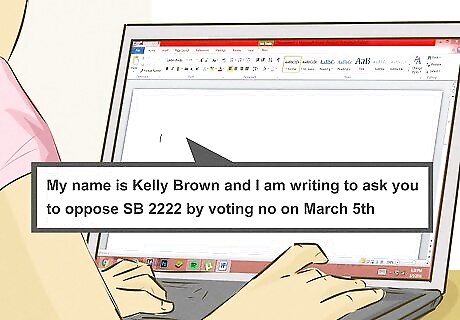
views
Planning Your Letter

Identify why you are writing your Senator. There are many reasons why you might contact your Senator. However, most people write because they want to share their opinion on something. For example, many constituents write their representatives for the following reasons: You want them to vote yes or no on a bill under consideration in the Senate. You want them to introduce a bill or hold hearings on a topic. You want them to approve or vote against the President’s appointees to the Supreme Court or cabinet.

Do some research. You will appear credible if you can speak confidently and accurately about an issue. If possible, you should find facts or statistics that you can cite in the letter. Remember to write down your sources, because you will want to list them in the letter. You should also know the name and number of the bill you are writing about. A good place to start with research is to do a basic Internet search. Spend an hour or so getting a general feel for the issue. If you need help, you can visit your local library and ask a librarian. Not all sources are the same. You want to use unbiased sources, such as government reports. University websites are another good source of credible information.

Find your Senator’s address. Visit this website: https://www.senate.gov/senators/senators-contact.htm. You should be able to find your Senator's name there. Click on their name to get their contact information. You'll be taken to their website, which should contain this information. If you don't know their name, look up your state first, then select the name that shows up.
Drafting Your Letter

Format your document using block-style paragraphing. It will look more professional. Write the letter as you normally would, but don't indent the new paragraphs. Instead, add a blank line between each paragraph. Set the font to 12 point size. Set the font to something readable, such as Times New Roman or Arial.

Insert the date. You should put the date in the upper left-hand corner. Write out the month, e.g., “January 12, 2017.”

Add your Senator’s address. Move down 2 lines and insert your Senator’s name and address. You should spell out your Senator’s full name in the address block. For example, “Honorable Susan Collins.” You can add a bolded title after the address. It should be centered between the left-and right-hand margins. For example, you could write “Re: Neil Gorsuch Nomination to the Supreme Court.”

Type your salutation. Move down two more lines and insert your salutation: “Dear Senator” is standard. You could also write “Dear Senator Collins.” Put a colon after the name.

Explain why you are writing. In the first paragraph, explicitly state why you are writing to your Senator. You can also introduce yourself, especially if your job is related to why you are writing. For example, you can write: “I am writing to urge you to vote against Judge Neil Gorsuch, who is President Trump’s nominee to the Supreme Court. I do not believe he respects the role our judiciary plays in protecting civil liberties.” Alternately, you could write, “I am a lawyer in southern Maine. I am writing to encourage you to support Judge Neil Gorsuch for the Supreme Court. As a practicing attorney, I had the pleasure of meeting Judge Gorsuch at an ABA conference a couple years ago and was immediately impressed with his integrity and intelligence.”

Support your opinion. Usually, you will write a letter to ask your Senator to vote a certain way. In the second paragraph, explain why. Remember to maintain a professional tone and avoid profanity or displays of anger. Mention specifics, if possible. For example, you could write: “I believe Judge Gorsuch is the wrong choice for the Supreme Court. The more I read about him, the more worried I am that he will overturn long-standing precedents in the Supreme Court.” Avoid relying on arguments made in a form letter. For example, if you belong to a group that sends out a letter telling you what to say, make your own argument instead. You can use more than one paragraph to make your argument, if necessary. However, try to keep your letter to one page.

Add personal details. Another good idea is to explain how the issue will touch you personally. For example, if the Senate is considering a farm bill, you can explain how not passing the bill will affect your family farm. You don’t need a sob story. Instead, you need a few personal details that let your Senator know how their vote will have real-world consequences.

Thank your Senator for their time. In the final paragraph, you want to thank them for reading your letter and considering your viewpoint. Also reiterate that the issue is important to you. Sample language might read: “Thank you for hearing my point of view on the Gorsuch nomination. The Supreme Court is a critical institution, and I hope you will vote against his nomination to maintain the independence of the judicial branch.”

Include a signature block. You should type “Sincerely,” and then leave four lines of blank space. You will put your name, address, phone number, and email address in a block. Remember to sign in the blank space using a dark ink pen.
Editing and Sending Your Letter

Revise your letter. Put your letter aside for a day or so and look at it with fresh eyes. Does your letter make sense? Have you said something in an unclear manner? If so, tinker with your sentences and paragraphs so that you are clearer. Also revise to make the letter as brief as possible. People are very busy. You might be able to combine sentences or paragraphs. Cut any unnecessary words.

Edit the letter. Typos, missing words, and other errors will reduce your credibility. Read over the letter to find these errors before sending. You can edit your letter by doing the following: Ask another person to read the letter to find mistakes. Read the letter backward. Start with the last sentence. Read it, then move to the sentence before it. This way, you’ll focus carefully on each sentence and find any errors. Read the letter out loud. Our eyes tend to correct errors when we read silently to ourselves. By reading out loud, you might stumble over an error.

Mail the letter if you don’t mind a delayed delivery. Due to the volume of letters the U.S. Senate receives and heightened security concerns, it takes approximately 1 month for a letter to reach a senator’s office via U.S. Mail. If it’s not necessary for your letter to be received as soon as possible (e.g., because it’s about a treaty renegotiation that won’t happen for several months), go ahead and send it by standard mail. If you wish, you can instead send it by certified mail with return receipt requested. The receipt will serve as proof that it was delivered. If you wanted to send a letter to one or both senators from Arizona, you’d use the following addresses: Senator Krysten Sinema, 317 Hart Senate Office Building, Washington, D.C. 20510; Senator Mark Kelly, 516 Hart Senate Office Building, Washington, D.C. 20510.
Fax your letter for a faster delivery. A fax will reach your senator’s office much more quickly than a mailed letter, and it may also feel more substantial than sending comments via your senator’s website. Find the fax number on your senator’s contact page, and be sure to include a cover sheet. For instance, the fax numbers for Arizona’s senators are (202) 224-4521 for Sen. Krysten Sinema, and (202) 224-2235 for Sen. Mark Kelly.
Submit comments via webform instead of standard email. Senators typically do not provide email addresses for constituent comments. Instead, their websites provide webforms for you to fill in with your contact information, topic (often from a drop-down list), and comments. If you have already drafted a letter, copy the body of it and paste it into the “comments” block on the webform. Senators create and operate their own websites. However, generally speaking, you’ll be asked to provide your name, address, email address, phone number, topic of your comments, and then your comments. For example, you’d submit comments to Arizona Senator Krysten Sinema at https://www.sinema.senate.gov/contact-kyrsten. Alternatively, you’d submit comments to Arizona Senator Mark Kelly at https://www.kelly.senate.gov/contact/contact-form/.

Read your response. Often, Senators won’t respond to letters. However, when they do, they send standardized responses. Don’t be offended. Check if your Senator voted how you wanted. If they did, thank them by sending a quick comment via their webpage. Senators usually receive lots of negative mail, so they'll appreciate the positivity.




















Comments
0 comment